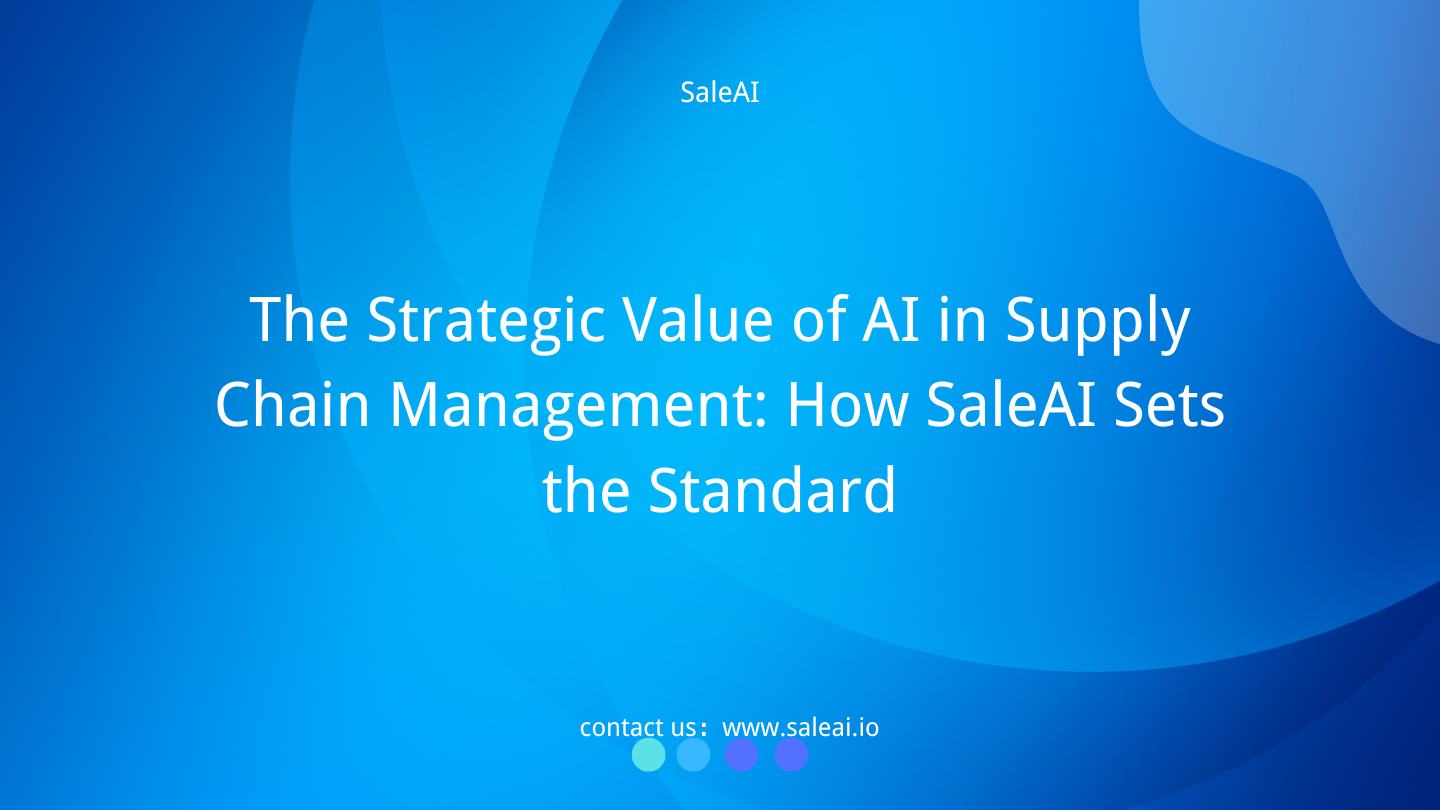What Happens When Strategy Meets AI in Supply Chain Management?
It’s easy to think of supply chain management as something operational—products moving from Point A to Point B. But in today’s interconnected global economy, supply chains are much more than that. They are strategic assets, capable of driving growth, reducing costs, and improving overall business performance.
Yet, managing these intricate networks has never been more challenging. Geopolitical tensions, fluctuating customer demands, and the sheer complexity of global trade make traditional supply chain management methods feel outdated.
So, what’s the solution? Artificial Intelligence.
With tools like SaleAI, businesses are unlocking new possibilities for their supply chains. AI doesn’t just automate processes—it transforms them, offering insights and optimizations that would be impossible to achieve manually. Think of it as moving from playing checkers to playing 4D chess.
Why Supply Chains Need AI—Now More Than Ever
a. Rising Complexity
From sourcing raw materials across continents to delivering finished goods to multiple markets, supply chains have become intricate webs. Managing them requires real-time data and precise coordination, which AI can provide.
b. Increased Uncertainty
Supply chains are increasingly vulnerable to disruptions, whether from natural disasters, pandemics, or geopolitical issues. AI helps anticipate risks and provides actionable solutions before problems arise.
c. The Demand for Speed and Efficiency
In a world where customers expect faster delivery and lower costs, businesses need to optimize every link in the supply chain. AI-driven tools like SaleAI excel at finding efficiencies that traditional methods miss.
How SaleAI Transforms Supply Chain Management
SaleAI is not just another AI tool—it’s a platform designed specifically for the complexities of global trade supply chains. Let’s dive into how it works:
a. Proactive Risk Management
AI’s ability to analyze vast amounts of data in real-time means businesses can identify risks before they materialize.
- Predictive Analytics: Anticipate supply chain disruptions, from port congestion to supplier delays.
- Scenario Planning: Simulate different outcomes and prepare contingency plans for potential disruptions.
- Risk Alerts: Receive instant notifications when there’s a potential delay or bottleneck.
The Impact: Stay ahead of challenges instead of scrambling to react.
b. Enhanced Supply Chain Visibility
Many businesses struggle with fragmented supply chains, where visibility is limited to certain segments. SaleAI changes this by providing end-to-end transparency.
- Real-Time Tracking: Monitor shipments, inventory, and supplier performance in real time.
- Data Integration: Combine data from multiple sources—customs records, logistics networks, and ERP systems—for a holistic view.
- Supplier Insights: Evaluate supplier reliability, lead times, and performance trends.
The Impact: Make faster, better-informed decisions with a complete picture of your supply chain.
c. Cost Optimization at Every Step
Every inefficiency in the supply chain costs money. SaleAI uses AI to identify and eliminate waste.
- Dynamic Route Optimization: Find the fastest, most cost-effective shipping routes based on real-time conditions.
- Inventory Management: Avoid overstocking or stockouts by predicting demand with precision.
- Supplier Negotiation: Use AI-driven insights to negotiate better terms with suppliers.
The Impact: Maximize profits by minimizing unnecessary expenses.
d. Demand Forecasting with Unmatched Accuracy
One of AI’s most valuable contributions to supply chain management is its ability to forecast demand accurately.
- Customer Behavior Analysis: Understand purchasing patterns and predict future demand.
- Seasonal Trends: Plan for peak periods with advanced seasonal forecasting.
- Market Trends: Align supply chain decisions with broader economic and industry trends.
The Impact: Avoid the costs of overproduction while ensuring you have enough inventory to meet demand.
e. Automation of Manual Processes
Many supply chain tasks, like invoice reconciliation or shipment scheduling, are repetitive and time-consuming. SaleAI automates these processes, freeing up your team for strategic work.
- Document Automation: Automatically process invoices, customs declarations, and shipping records.
- Workflow Automation: Streamline approval processes with AI-powered tools.
- Compliance Management: Ensure adherence to international trade regulations without manual oversight.
The Impact: Boost efficiency and reduce the risk of human error.
What Sets SaleAI Apart in Supply Chain Management?
a. Purpose-Built for Global Trade
SaleAI isn’t a generic AI tool—it’s specifically designed for the complexities of international supply chains, from customs data analysis to cross-border logistics.
b. AI That Learns
The more you use SaleAI, the smarter it becomes. Its machine learning algorithms continuously improve, adapting to your business needs.
c. Integration-Friendly
SaleAI works seamlessly with your existing systems, from CRMs to ERP platforms, ensuring a smooth transition and maximum ROI.
d. Proven Results
With over 6,000 satisfied clients, SaleAI has a track record of delivering measurable improvements in supply chain efficiency and cost savings.
Who Benefits Most from AI-Powered Supply Chain Management?
Exporters and Importers
Optimize international shipping, reduce customs delays, and manage supplier relationships more effectively.
Manufacturers
Streamline sourcing, inventory management, and production planning for better efficiency.
Logistics Providers
Enhance route planning, reduce shipping costs, and improve delivery reliability.
Retailers
Ensure stock availability while minimizing inventory costs through precise demand forecasting.
How to Get Started with SaleAI for Supply Chain Optimization
- Identify Pain Points: Determine which aspects of your supply chain—visibility, costs, or risks—need improvement.
- Leverage SaleAI’s Expertise: Work with SaleAI’s team to integrate its tools into your existing workflows.
- Monitor and Adjust: Use SaleAI’s real-time analytics to track performance and optimize continuously.
- Scale for Growth: Expand SaleAI’s usage as your business grows, ensuring your supply chain remains efficient and competitive.
Conclusion: The Future of Supply Chain Management is Here
Supply chains are no longer just operational—they’re strategic. Businesses that fail to adapt to this reality risk falling behind. SaleAI’s AI-powered supply chain tools provide the insights, automation, and optimizations needed to stay ahead in today’s competitive global trade environment.





